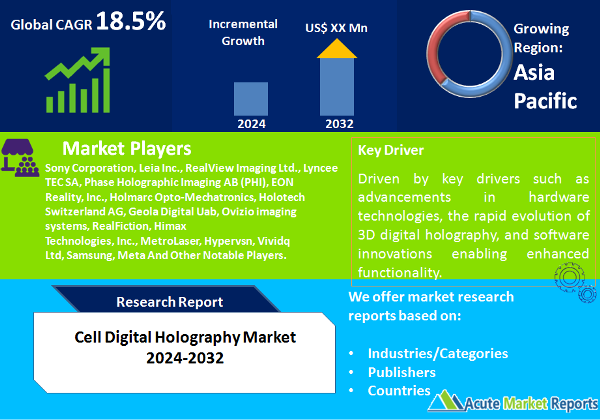
The digital holography market, a cutting-edge technology in the realm of imaging and visualization, is poised for significant growth from 2025 to 2033. The digital holography market is expected to grow at 18.5% during the forecast period of 2025 to 2033, driven by key drivers such as advancements in hardware technologies, the rapid evolution of 3D digital holography, and software innovations enabling enhanced functionality. However, challenges in standardization and interoperability pose significant restraints that need to be addressed for the seamless integration of digital holography across industries. The nuanced segmentation of the market by offering and dimension provides insights into the balanced contributions of hardware and software components, as well as the relevance of 2D and 3D technologies in different applications. Geographically, the Asia-Pacific region emerges as a key driver, reflecting the region's emphasis on technological advancements. As the market progresses into the forecast period, these drivers, challenges, and competitive dynamics are expected to continue influencing the digital holography market, making it a transformative and evolving segment within the broader field of imaging and visualization technologies.
Advancements in Hardware Technologies: Fueling digital holography Innovation
The digital holography market is propelled by continuous advancements in hardware technologies. Evidence includes the development of high-resolution sensors, efficient light sources, and sophisticated optical components, all contributing to the enhanced performance and capabilities of digital holography systems. This driver is underscored by the increasing investment in research and development by key industry players, leading to the introduction of state-of-the-art hardware solutions. As evidenced by the introduction of digital holography systems with improved resolution, sensitivity, and real-time processing capabilities, the market is witnessing a transformative phase driven by the relentless pursuit of technological innovation.
Rapid Evolution of 3D digital holography: Expanding Applications Across Industries
The digital holography market is experiencing rapid growth due to the evolution of 3D digital holography. Evidence includes the expanding applications of 3D digital holography across various industries, including healthcare, automotive, and aerospace. This driver is highlighted by the increasing adoption of 3D holographic displays, holographic microscopy, and holographic imaging techniques in medical diagnostics, automotive design, and scientific research. As evidenced by the growing demand for 3D digital holography solutions to address complex visualization challenges and improve precision in different sectors, this driver is expected to be a key contributor to the market's expansion from 2025 to 2033.

Software Innovations Driving Enhanced Functionality: Enabling Advanced Data Analysis and Visualization
The digital holography market is witnessing substantial growth propelled by software innovations that enhance functionality. Evidence include the development of advanced algorithms, data processing software, and user-friendly interfaces, enabling users to extract meaningful information from holographic data with greater ease. This driver is emphasized by the integration of artificial intelligence and machine learning techniques in digital holography software, facilitating automated analysis and real-time visualization. As evidenced by the growing emphasis on software advancements to complement hardware capabilities, this driver is expected to shape the market by providing users with powerful tools for in-depth holographic data analysis and interpretation.
Challenges in Standardization and Interoperability: Navigating the Complex Landscape
A notable restraint in the digital holography market is the challenges associated with standardization and interoperability. Evidence include the diverse array of digital holography technologies, formats, and file standards, creating a complex landscape for users and hindering seamless interoperability. This restraint is further emphasized by the absence of universally accepted standards, leading to compatibility issues and limitations in the exchange of holographic data between different systems. As evidenced by the industry's ongoing efforts to establish common standards and protocols, addressing these challenges is crucial for fostering widespread adoption and integration of digital holography technologies across diverse applications.
By Offering: Hardware Offerings Dominate the Market
In 2024, the digital holography market demonstrated substantial revenue from hardware offerings, including holographic cameras, sensors, and displays. Simultaneously, software offerings exhibited the highest CAGR during the forecast period from 2025 to 2033, indicative of the growing recognition of software's role in unlocking the full potential of digital holography systems. This nuanced segmentation illustrates the balanced contribution of both hardware and software components to the overall growth and evolution of the digital holography market.
By Dimension: Three-dimensional (3D) digital holography Dominates the Market
The digital holography market showcased significant revenue from Three-dimensional (3D) digital holography in 2024, reflecting the increasing demand for immersive and realistic holographic visualizations. Simultaneously, Two-dimensional (2D) digital holography exhibited the highest CAGR during the forecast period, signifying its relevance in applications requiring precision and simplicity. This comprehensive segmentation highlights the diverse applications and preferences within the digital holography market, with both 2D and 3D technologies catering to specific user requirements and industry needs.
APAC Remains the Global Leader
Geographically, the digital holography market exhibited dynamic trends in 2024, with the Asia-Pacific region leading in revenue generation and the highest CAGR. This reflects the region's strong focus on technological advancements, research and development activities, and the increasing adoption of digital holography across industries. North America also contributed significantly to revenue, driven by a mature technology landscape and the presence of key industry players. Europe, while demonstrating a robust market, experienced a slightly lower CAGR, indicative of the established nature of the technology in the region. This geographic segmentation underscores the global nature of the digital holography market, with different regions playing distinct roles in shaping its trajectory.
Competition to Intensify during the Forecast Period
In the competitive landscape, top players such as Sony Corporation, Leia Inc., RealView Imaging Ltd., Lyncee TEC SA, Phase Holographic Imaging AB (PHI), EON Reality, Inc., Holmarc Opto-Mechatronics, Holotech Switzerland AG, Geola Digital Uab, Ovizio imaging systems, RealFiction, Himax Technologies, Inc., MetroLaser, Hypervsn, Vividq Ltd, Samsung and Meta are instrumental in steering the digital holography market. These industry leaders, with their extensive portfolios, global presence, and strategic initiatives, have significantly influenced market dynamics. In 2024, these companies demonstrated strong revenues, and their continued investments in research and development, along with collaborations and partnerships, position them as key contributors to the market's growth. As the digital holography market progresses into the forecast period from 2025 to 2033, these industry leaders are expected to maintain their dominance and play a pivotal role in shaping the market's future.
Historical & Forecast Period
This study report represents analysis of each segment from 2023 to 2033 considering 2024 as the base year. Compounded Annual Growth Rate (CAGR) for each of the respective segments estimated for the forecast period of 2025 to 2033.
The current report comprises of quantitative market estimations for each micro market for every geographical region and qualitative market analysis such as micro and macro environment analysis, market trends, competitive intelligence, segment analysis, porters five force model, top winning strategies, top investment markets, emerging trends and technological analysis, case studies, strategic conclusions and recommendations and other key market insights.
Research Methodology
The complete research study was conducted in three phases, namely: secondary research, primary research, and expert panel review. key data point that enables the estimation of Digital Holography market are as follows:
Market forecast was performed through proprietary software that analyzes various qualitative and quantitative factors. Growth rate and CAGR were estimated through intensive secondary and primary research. Data triangulation across various data points provides accuracy across various analyzed market segments in the report. Application of both top down and bottom-up approach for validation of market estimation assures logical, methodical and mathematical consistency of the quantitative data.
| ATTRIBUTE | DETAILS |
|---|---|
| Research Period | 2023-2033 |
| Base Year | 2024 |
| Forecast Period | 2025-2033 |
| Historical Year | 2023 |
| Unit | USD Million |
| Segmentation | |
Offering
| |
Dimension
| |
Application
| |
End-Use
| |
|
Region Segment (2023-2033; US$ Million)
|
Key questions answered in this report